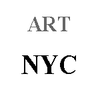Draw a clear goal and blur it again
The direction that ART NYC should go and the things that need to be prepared to achieve it has been set. But I tore it apart again and spread it out like a puzzle. First, pick up anything and put it on the puzzle board. Where do you start, and how do you put this big, colossal puzzle together?
I applied for an online course at Sotheby's in 2019. It was a class I took online about the art market for about a month, and I submitted assignments, but I think I paid quite a lot of money. Why do I want to study the art market? I want to know if there is a particular source for marketing. There was something I felt a lot while taking this class. There is nothing much to it. Of course, the data provided was excellent. The professor was excellent, and the system and quality of the class were very high. But there was no new content or answer I didn't know. And the professor's pronunciation was a little hard to understand. It seemed more difficult for foreigners like me because English was the pronunciation of a non-native person. But I also gained confidence. If you have the expertise, English pronunciation is not essential. I can do something too!!
In the Sotheby's course, I studied the overall contents of the art market, such as the growth of the online market, the difference between artworks and other luxury products, and how the art market was composed, but it was still full of frustration. Collectors need answers such as how to choose good works, and galleries need straightforward solutions such as selling pieces and increasing sales. The way to escape from this foggy path to the vast land was to make and provide this answer myself.
There was an art note that I had made since I was in middle and high school, and it was my note that was constantly recorded and updated in art history class. And I didn't throw away my high school art textbook and always put it on the bookshelf. I threw away all the other textbooks at the end of the semester, but I thought this material might give me a critical answer someday. Yes, all the answers were in the textbook. The most memorable passage of the textbook was that good works must have a representation of the times. It is only natural that there should be workability. But would it be easy to understand if I explained this to the general public? Not at all. For example, if you pardon the work and the situation together, it will be easier to understand. Just as memorizing mathematical formulas did not solve all the problems, art collecting had to learn the senses by continuing to solve practice and application problems. This is why YouTube <Artist TV - To be the super rich> It is a pity that most of the contents are unaware of it, even though it is the same as the answer to art collecting, which is so clearly organized. I'll show you my work and tell you everything I know I wanted to. So far, more than 60 videos have been uploaded. In the meantime, there have been more than 1,000 subscribers. It's not a large number compared to other YouTubers, but 1,000 people subscribed to my video, which means that this video is helping at least 1,000 people. I'm thrilled, and I'm starting to get unexpected bonuses. It was connected to a trusting relationship with good people who had no connection. When I tried to help the nation, it ended up being a boomerang to me.
It can be easy to understand if you explain it to people through video and sound. You can listen to YouTube while washing dishes and commuting. But there's something that it can't do. There is a concept of organization and order that only text can give.
From now on, I would like to write about the lectures on becoming rich through art investment, one by one, with the puzzle of ART NYC.
https://medium.com/@Artnycinc/set-goals-and-draw-and-then-it-scatters-like-its-making-a-puzzle-again-334eb9539137



